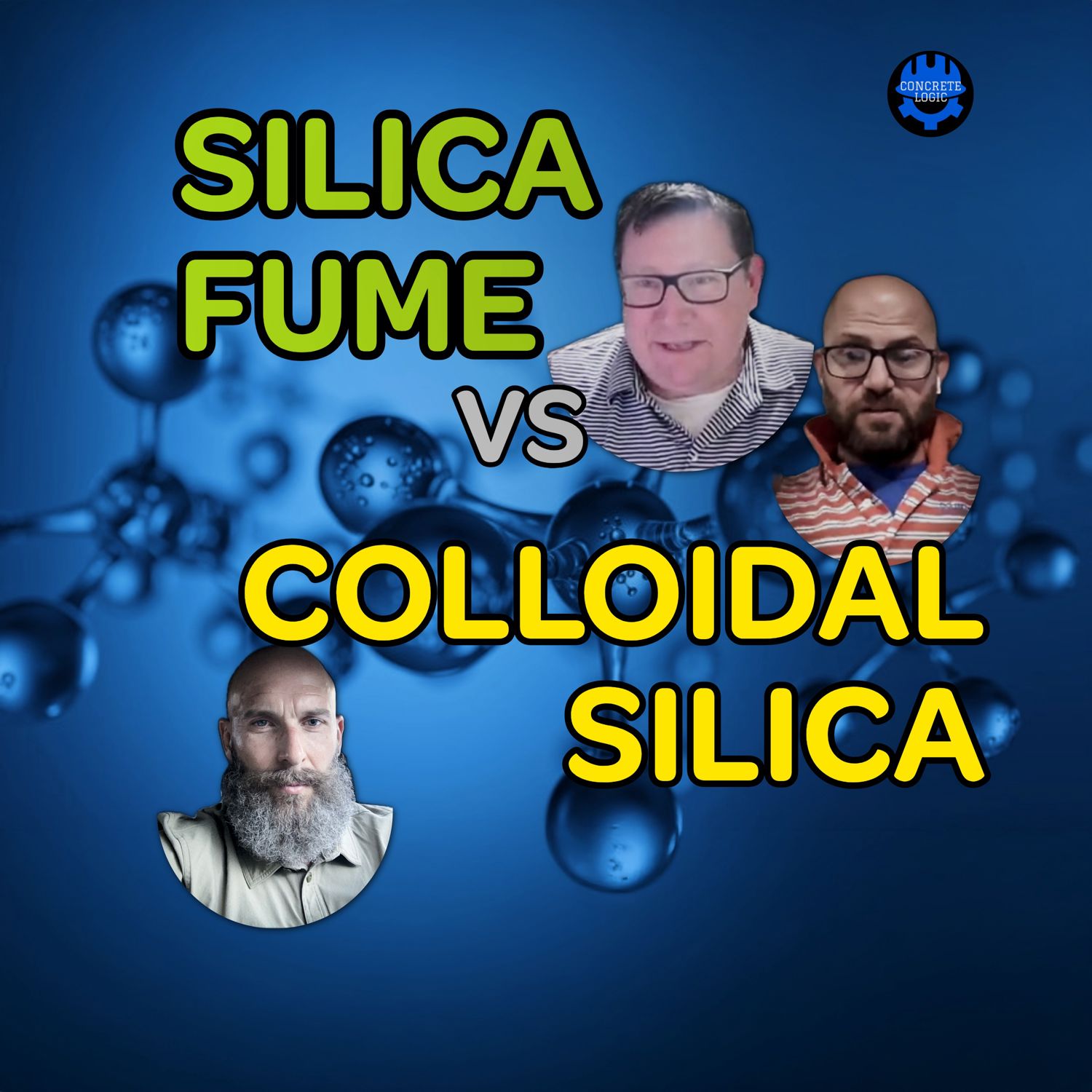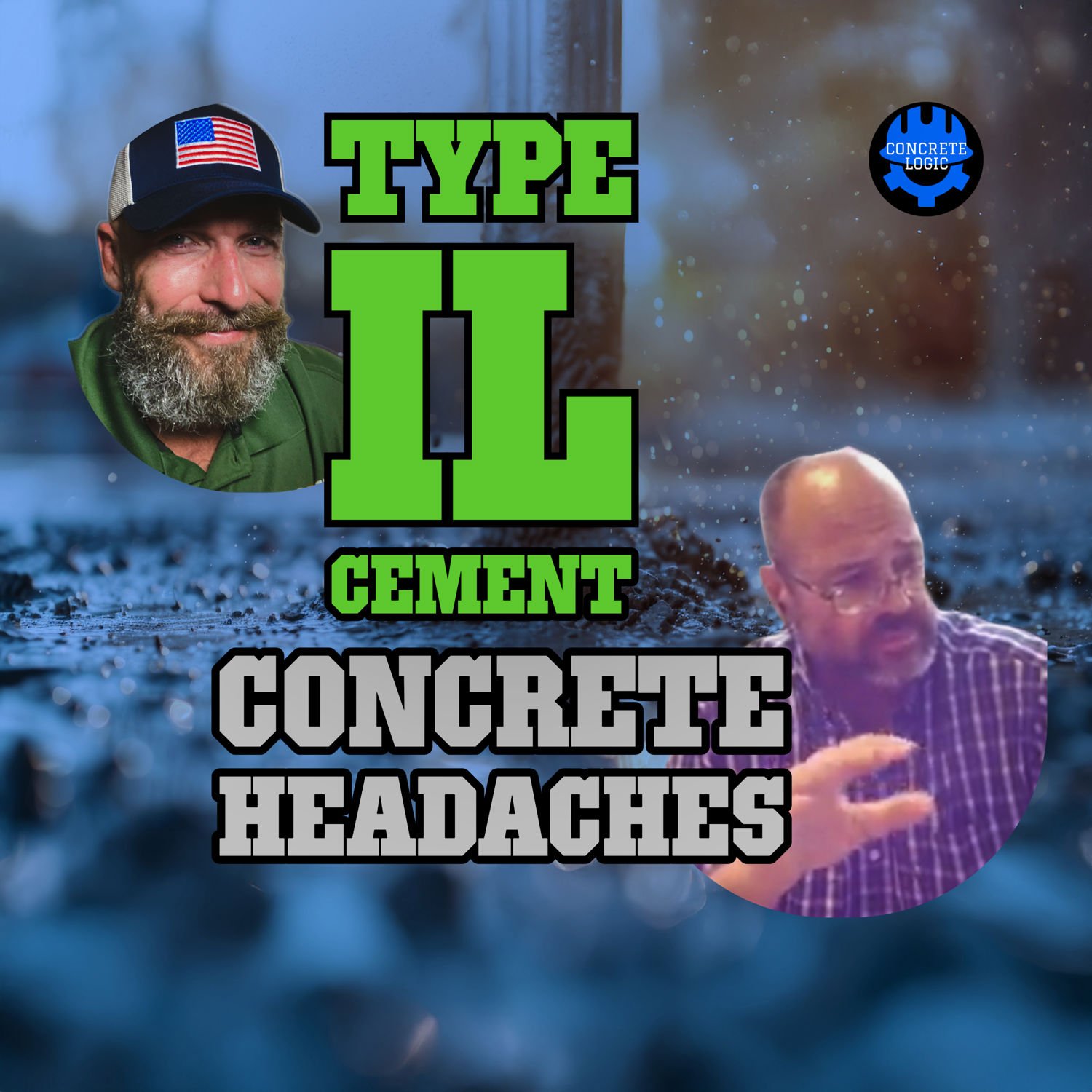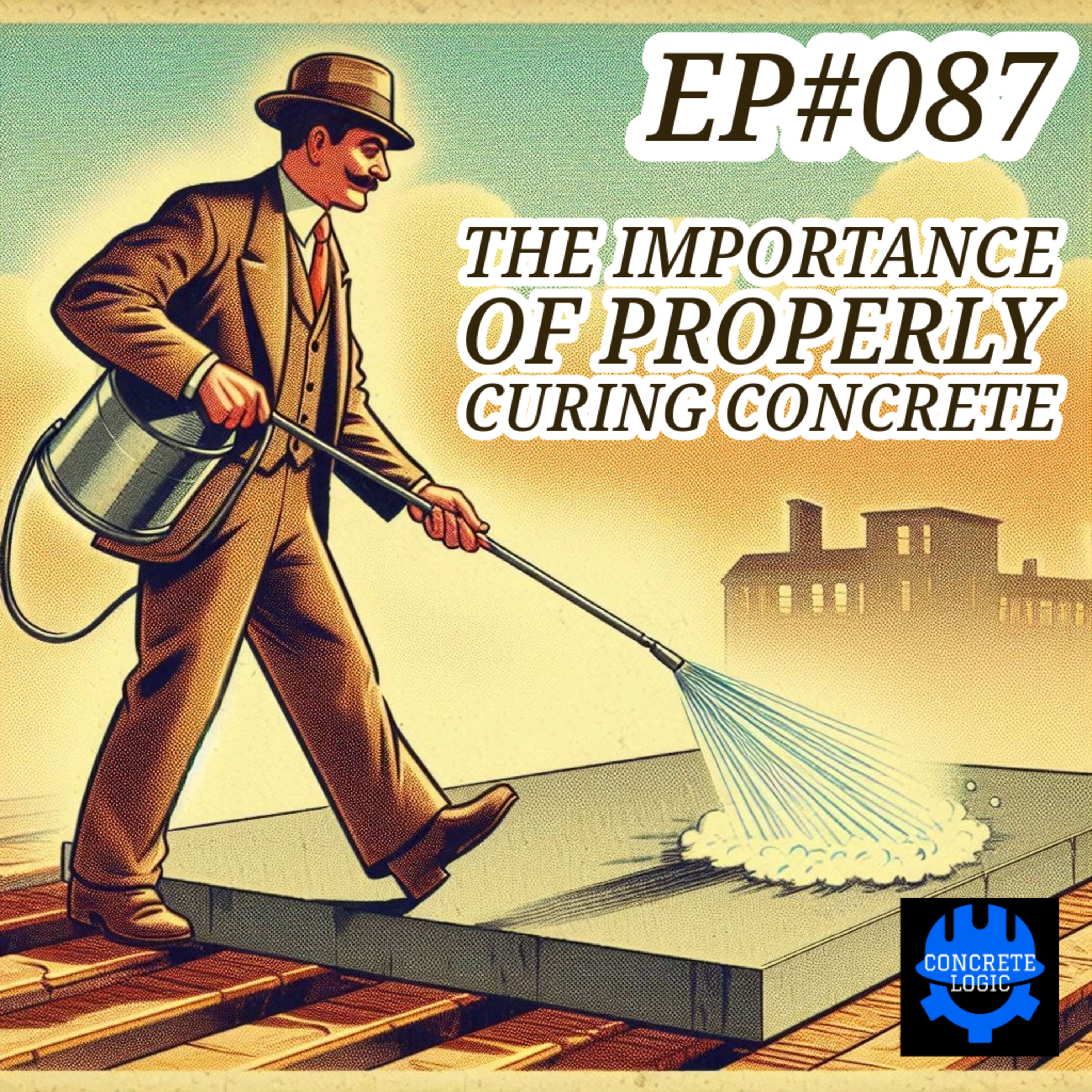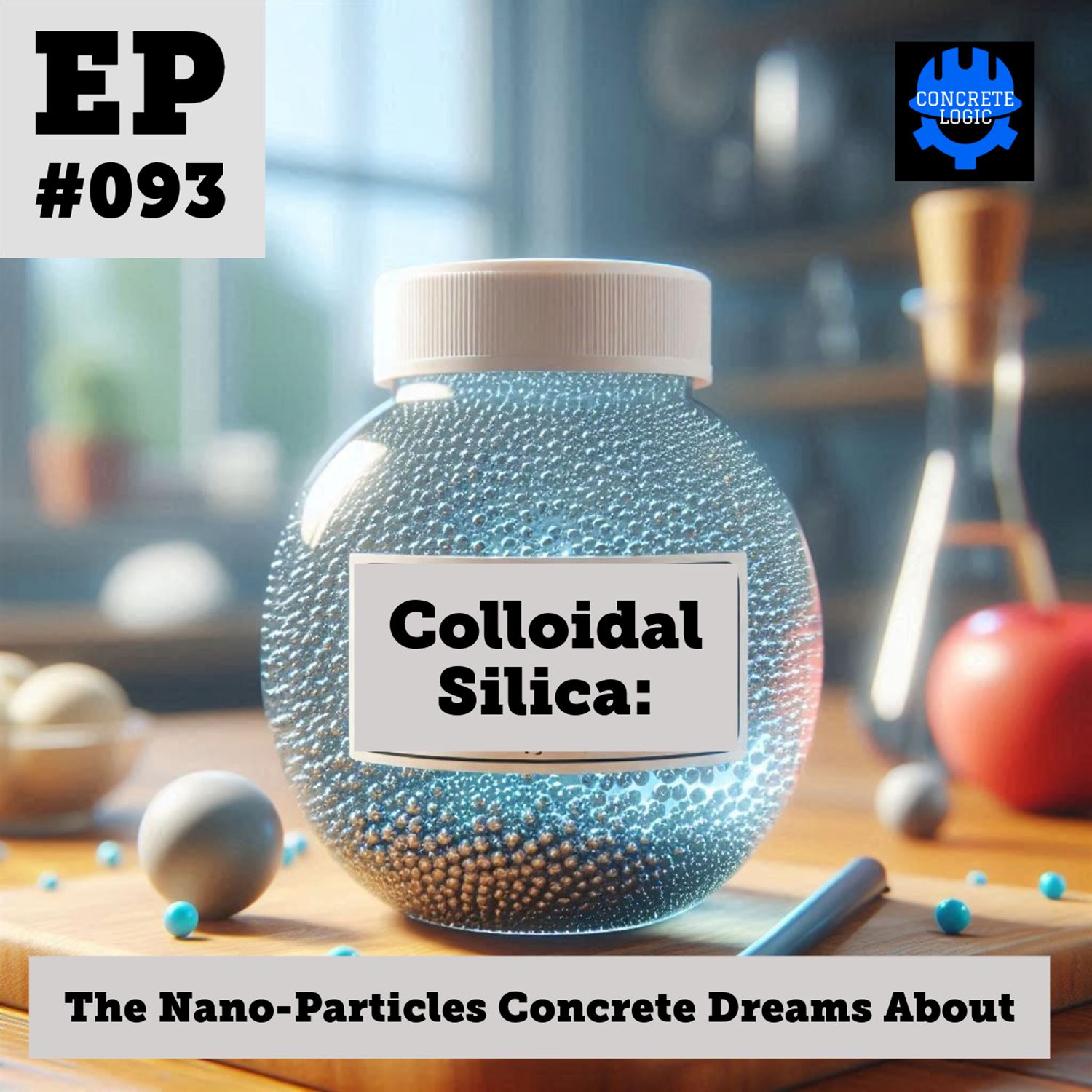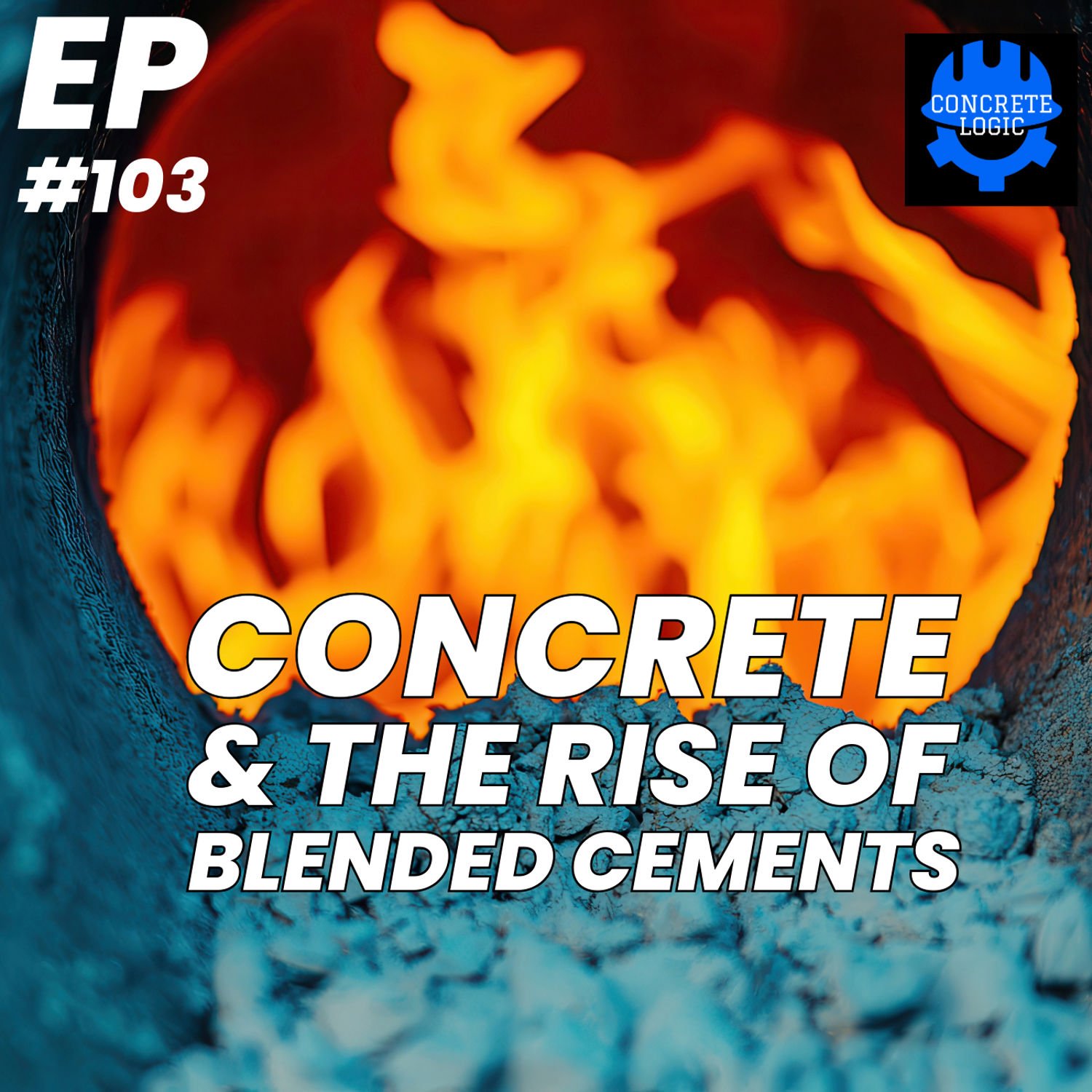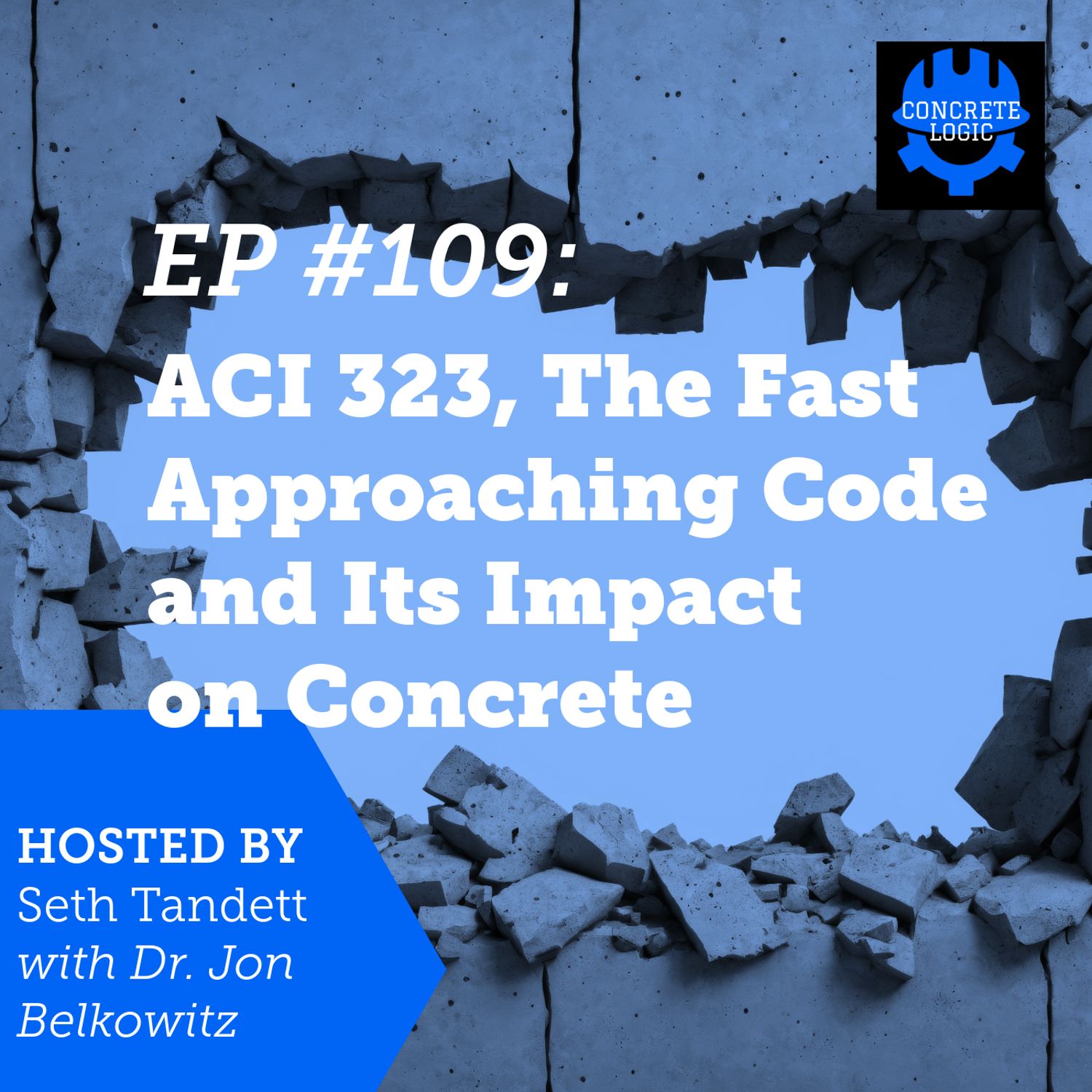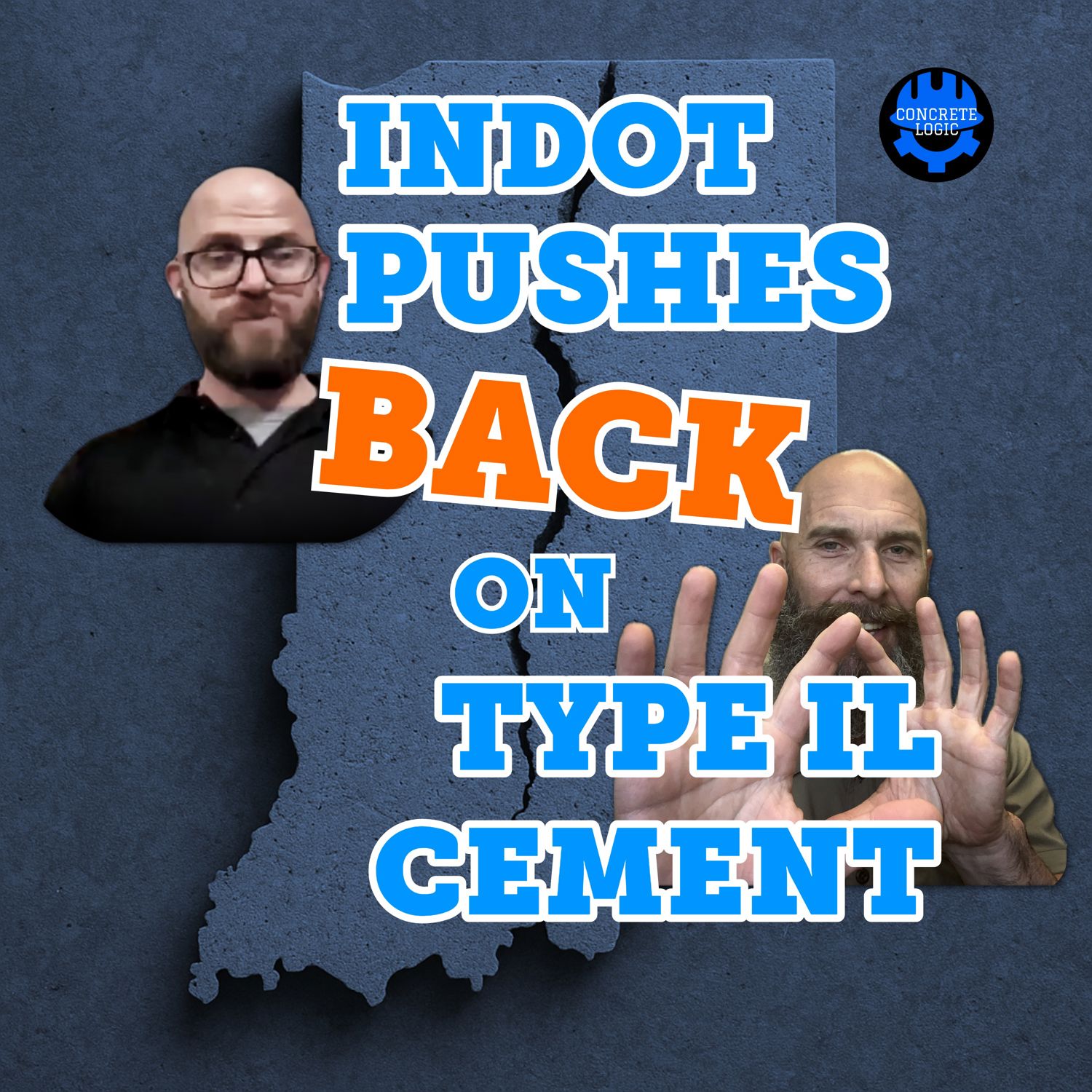EP #110: Revolutionizing Concrete with Biocarbon
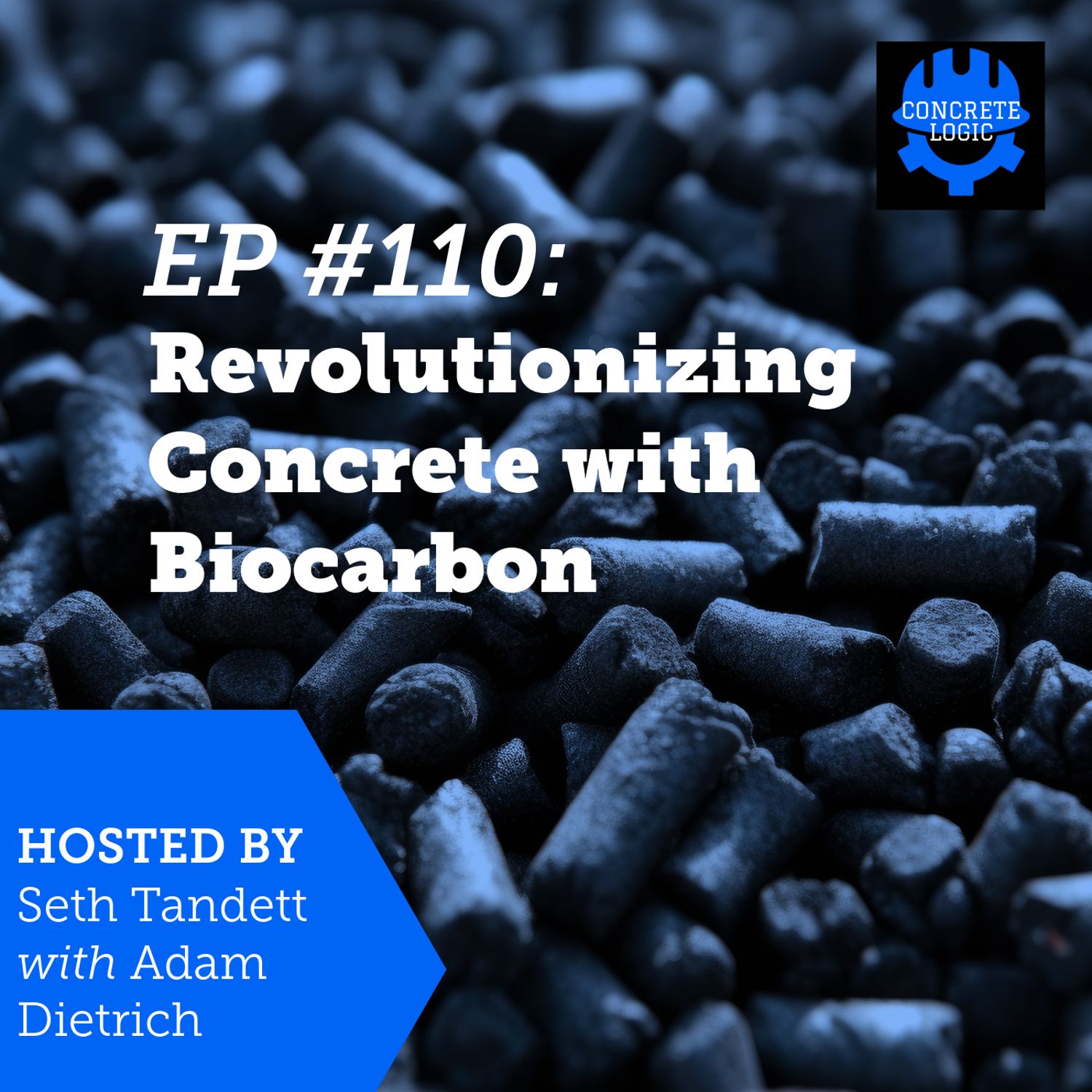
In this episode of the Concrete Logic Podcast, Seth Tandett interviews Adam Dietrich from Dama Bioplastics to discuss the innovative use of biocarbon in various industries, particularly in concrete. Adam explains the production process of biocarbon, its applications, and how it can enhance concrete hydration.
The conversation also covers the challenges and opportunities in scaling biocarbon production, its role as a carbon black replacement in the automotive industry, and the potential for collaboration within the concrete sector.
Takeaways
• Biocarbon can potentially enhance the hydration process in concrete; possible internal curing attribute.
• The production of biocarbon is carbon negative, contributing to sustainability efforts.
• The material can be used as a fine sand replacement in concrete mixes.
• Testing has shown that biocarbon can perform comparably to traditional materials in concrete applications.
• Scalability is a focus, with plans to relocate production to areas with suitable feedstocks.
• Collaboration with other industries, such as automotive, is key to expanding biocarbon's applications.
Chapters
00:00 Introduction to Biocarbon and Dama Bioplastics
12:00 Biocarbon in Concrete: Testing and Results
21:59 Scalability and Future Directions for Biocarbon
30:04 Collaboration Opportunities and Industry Challenges
***
Did you learn something from this episode? Would you like to support the concrete industry's favorite podcast?
If so, donate at https://www.concretelogicpodcast.com/support/ .
When YOU donate to the show, you will be listed as a producer of the next episode that is released!
Join the Concrete Logic Academy!
Enhance your learning from our podcast with engaging quizzes that test your knowledge and help you earn Professional Development Hours (PDHs).
Support Concrete Logic and take your education to the next level! 🚀
FIND OUT MORE HERE: https://www.concretelogicacademy.com/
***
Episode References
Guest: Adam Dietrich | Dama Bioplastics | adam@damabioplastics.com
Guest Website: https://www.damabioplastics.com/
Producers: Jodi Tandett
Donate & Become a Producer: https://www.concretelogicpodcast.com/support/
Music: Mike Dunton | https://www.mikeduntonmusic.com | mikeduntonmusic@gmail.com | Instagram @Mike_Dunton
Host: Seth Tandett, seth@concretelogicpodcast.com
Host LinkedIn: https://www.linkedin.com/in/seth-tandett/
Website: https://www.concretelogicpodcast.com/
LinkedIn: https://www.linkedin.com/company/concrete-logic-podcast
Why join the Concrete Logic Academy?
You get access to:
• Hands-On Video Courses
• Live Q&A Sessions
• Collaborative Projects
• Live Podcast Recordings
• Concrete Library
• Professional Development Hours (PDHs)
Learn more: https://www.concretelogicacademy.com/
Seth Tandett (00:01.51)
Welcome to another episode of the Concrete Logic Podcast and today I have Adam Dietrich with Dama Bioplastics. We're gonna talk about biocarbon. Brand new topic for the podcast, but concrete adjacent. So, hope you guys learned something today. But before we get started, I just wanna remind everybody how you can support the podcast or Concrete Logic as a whole. There's several things you can do for me.
Adam Dietrich (00:01.894)
I'm going to go ahead and stop the video.
Adam Dietrich (00:08.326)
Thanks.
Adam Dietrich (00:15.75)
you
Adam Dietrich (00:22.854)
you
Seth Tandett (00:30.082)
One is if you enjoyed today's episode, please share it, pass it on to a colleague or a coworker. The next thing you can do is if you go to ConcreteLogicPodcast.com on the homepage, there's a couple ways you can get ahold of me. At the top of the page, there's a little contact link. You click on that. That's like sending me an email. And then on the bottom right-hand corner on the homepage, there's a little microphone. If you click on that, it's like leaving me a voicemail or record your voice right there off the computer.
Seth Tandett (00:59.002)
What I'm looking for are guest or topic suggestions So if you have a guest or a topic that you want to hear on the podcast, please reach out and let me know what you want to hear and then The next way you can support the show is on the same home page of concrete logic podcast comm There's a donation button so if you learn something or you if the episode or any of the hundred plus episodes that we
Seth Tandett (01:28.574)
Put out there if any of them are some kind of value Just hit the donate button you can give any amount and every any or every amount is is appreciated helps helps keep this podcasting going does cost money to put a podcast out there believe it or not and then the last way is if you are Someone that wants to get involved more and get into the conversation about the direction of where the industry is going
Seth Tandett (01:56.914)
we have started the Concrete Logic Academy. And what you can do there is you can join us there. It's a little social networking group that you can get on there and just think of it as a mini LinkedIn for Concrete. There's that you can do, or we also have courses that you can take. the same kind of material that you hear on the podcast we've got within the Academy.
Seth Tandett (02:23.76)
And what we've done is put some quizzes together that you take at the end and to make sure you're understanding or comprehending or getting the ideas out of that particular episode. And then once you finish those, what we can do since there's quiz and objectives for that, we can actually give you professional development hours now. So.
do that, can jump in and do that. know that architects and engineers, need the professional development hours every year. So jump in there and you can do one specifically for concrete. But yeah, that is it. Adam, let's get into it. Adam is now Chief Technical Officer for Dahme Bioplastics. can you?
Adam Dietrich (03:07.206)
So, I'm happy to say it's time.
Seth Tandett (03:16.862)
explain what you're up to and why do you want to talk to the Concrete Logic audience today.
Adam Dietrich (03:24.654)
Yeah, so yeah, appreciate you having me on. know, Dama Bioplastics has been around officially since 2002 and what we've been looking to create are raw materials, drop-in replacements for commercial use within different industries that are just utilizing product that is either
reducing the actual quality of the finished product or the consistency of that material is changing on a consistent basis. so producing a biocarbon is just something that really provides these end products with an interior structure that allows for a lot more nucleation in bonding sites so that strength can be enhanced.
We've been working a lot on the polymer side, but in doing so, we've really seen that some issues of moisture hold and that kind of creating an issue on the plastic side has kind of given us an entry into a possible solution for concrete in long-term hydration. In this issue of just new...
cementitious materials, pozzolanic materials being so small in particle size, that they're just really taking up a lot of that initial water that needed to be kind of within that matrix for a longer period of time. We feel this carbon can be a solution to that. And so to give just a background on biocarbon, any type of
plant can be turned into a bio-carbon. Really anything can be turned into, it's carbon. Everything's made of carbon. There's certain percentages of different items that either have a 40 % or up to 50 % carbon content. And some of that within the bio side, like trees, hardwood trees have a high
Adam Dietrich (05:47.526)
carbon content up to about 45%. And so when you can take the waste from forestry, deforestation, where they're just removing a lot of this debris, that can be utilized in a lot of efficient ways. And so what we do is we take materials and put through pyrolysis, we create the biocarbon. It's a similar material to biochar. The only difference is
We do a much more controlled temperature gauge of how long this material is at each temperature range to produce the needed carbon without producing a lot of additional ash. And so just that controlled environment, you know, really avoids the kind of miss or production of organic
in ash content. And so, you know, that's really like really, excuse me, where we separate ourselves from, you know, other materials out there on the market is we have to have consistency and we have to have high percentages of carbon. And so, you know, that processing method that we use, you know, is just very necessary and proprietary, but you know, get you to that higher quality.
Seth Tandett (07:13.936)
Okay, so it's a it's is it a powder liquid? would it look like to to us once it's?
Adam Dietrich (07:22.726)
Yeah. So it's a, for what we're doing with internal cure and just the ability of holding as much water as possible, would be a fine sand replacement, that kind of spec. So it's like 150 micron spec.
Seth Tandett (07:36.734)
Okay.
Seth Tandett (07:43.016)
So is there a particular ASTM or something that you all are trying to fall in line with so it's easier for you to, because that's the things when we hear from people that are using a novel material for concrete. They're like, hey, this is new. It's never been used for concrete before. So you got to kind of find out, hey, is it like a blended cement or is it a admixture?
whatever, and there's these ASTM buckets that you gotta fit in so that you have an avenue to actually try it out, because otherwise it's a long haul to get everybody to try to use your new material for concrete.
Adam Dietrich (08:13.242)
Yep.
Adam Dietrich (08:30.374)
100%. Yeah, we're looking at the C176 lightweight aggregate for internal cure of concrete. And then that's where that spec comes in. We've utilized this stuff in a multitude of different particle sizes, one of which was 38 micron just to match Portland. And that went really well as well.
The one thing that we're looking at though is as the market turns more nanoparticle, we need to not go along with it to the point where we're stealing the water. Because what happens when you break down these carbons to a certain point, you break down the macro pores, you break down just its ability to really efficiently store water without being an inconsistent variable.
because the powder could just, it could sequester 500 % of its weight. could, it could sequester 150 % of its weight, but depending on where that particle size is, it's, you know, it's necessary to hit a consistent point. So we don't want to be that hindrance or continued hindrance into the matrix. and so yeah, you know, looking at where we would be consistently providing, you know, a solution it's.
right at that fine sand. And it would be a volume replacement at about 2%. And you need about seven pounds of internal water for curing per 100 pounds of cementitious material. We can store about 150 % of our weight in water in our Dama Black lightweight aggregate. And so that requires then about four
4.67 pounds of Dama Black per 100 pounds of cementitious materials to achieve that seven pounds of internal cure water.
Seth Tandett (10:43.686)
Okay. So like,
competitor I went I guess the best way to describe it would be the the lightweight aggregate it you're trying to replace that is that if I guess a first initiative for you guys or or an alternate
Adam Dietrich (11:01.998)
Yeah, I mean, be it. Complementary, you know, and it's one of those things that it's also can be a bit complementary in the sense of long term hold. The difference that we have within our pore structures is we've got macro pores, meso pores and micro pores, all with different pore diameters. And so you have a lot of really small tunnels deep inside these particles that.
you know, water could be stored. It's different than a traditional expanded material aggregate, lightweight aggregate based on just particle size distribution, as well as the way in which these particles, I think it's a lot more longitudinal, poor creation like that is within those types of materials. So this can actually be a complimentary piece where we could be that extended period of hydration.
for those pozzolanics, things that take up to 90 days to reach their high strength. But wouldn't ever want to just be a full replacement to anybody if there are ways of also being a comp.
Seth Tandett (12:17.022)
What are you currently using biocarbon for that maybe we can, because I'm sure you didn't start it and say, we're only going to serve the concrete industry. You're serving other industries as well?
Adam Dietrich (12:34.702)
Yeah, yeah, not only did we choose one of the hardest industries concrete, we chose the other hardest industry, the automotive industry to put this stuff into. And so what we are doing now is we're partnered with Polestar out of Sweden. They create electric vehicles and their goal for 2030 is to create a carbon neutral production vehicle. And so what we've been introduced to through them and thanks to them is
all of their tier one, tier two manufacturers. And so for the last two, almost three years now, all of these manufacturers have been working with Dama Black in different particle size variations to work as a carbon black replacement. And carbon black is a petroleum byproduct. It's the soot that kind of is within the chimney system, which is the
non-combusted kind of byproduct of that industry. And that has become such a prevalent material within all industries. I mean, it's in cosmetics, it's in paints, it's in auto parts, it's in everything. And so what we bring to the table there for Polestar is every ton of material that we produce is a carbon negative.
end product because of where this materials come from and how it's produced. And so it helps for them in a long run of creating this carbon neutrality vehicle. But what they're finding also is that it's a weight reducer. And so it's half the weight of carbon black and it gives them a way of offsetting all this weight that they've been adding to the vehicles with their batteries. So it's been a great
you know, opportunity where we've looked at so many different ways of incorporating this stuff into their existing manufacturing, all the way to tires and now looking at rubber and how this can be a replacement into rubber. But with that, we've seen that this stuff holds a lot of moisture. And so working with them kind of gave us that.
Adam Dietrich (14:57.51)
It's like, how do we use this benefit and not have to work against ourselves every time and dry this stuff to a point where we have to remove this? How can we use this moisture that's just naturally there? We have to add to it, you know, and get that pre-wetted weight. But that led us into, you know, concrete as well. I mean, we've bypassed the issues with automotive and, you know, they're using the material, but that issue really gave us the idea for concrete.
Seth Tandett (15:26.974)
so just for my education, you called it carbon black. it's my understanding is oil basically is in all plastics, right? Is that what you all are trying to replace in the plastics? Is that what it is? is it a, I guess, an end result of using oil?
Adam Dietrich (15:34.266)
Yeah.
Seth Tandett (15:56.328)
that they're putting in the plastics.
Adam Dietrich (15:58.68)
Yeah, it's some of the oil that's being replaced. In plastics, it's all a poly material. So it's an oil-based material that's coming in to create the plastic itself. The carbon black was just that added oil-based byproduct that they've been using for colorant and UV protection forever. It was just kind of creating a material from a commodity.
Seth Tandett (16:20.421)
really?
Adam Dietrich (16:27.856)
from a byproduct in the beginning. The one thing that we've been told is that our stuff, because it's not oil-based, it cleans up so much better. It's better for you. It doesn't absorb into your skin if it gets on your body. so plastic guys really like it. It's just different, but it's still a drop-in replacement in the sense of how we've been utilizing Carbon Black compared to what we're introducing now.
But yeah, carbon black is a gross stuff. to see that it's in cosmetics is pretty wild. But this stuff that we produce, the variation of feedstock is what is needing the dialed in. for our company, we've got a carbon library of every feedstock we've ever used, what carbon is created from that feedstock, and then what applications.
Seth Tandett (16:59.326)
Hmm.
Adam Dietrich (17:25.466)
that can go into, because not every carbon can do what it needs to do in every application. You have to have a hard wood or a soft wood. Soft woods have a lot more macro pores because it's just a softer, kind of fluffier wood tissue. And then a hard wood's got a lot more macro pores, excuse me, just because everything's so much more condensed. So you look like a Janka scale of hardness and that's...
Seth Tandett (17:42.494)
Mm.
Adam Dietrich (17:54.502)
The higher the hardness, it just dominates in micropores.
Seth Tandett (18:00.446)
Before we hit record you were sharing with me that you're actually doing some test pours of it with concrete. So when you all are using it you've mentioned the internal cure effect that it's having, right? Is there anything else that you all have come across that you find that could be beneficial for concrete?
Adam Dietrich (18:30.168)
Absolutely. Yeah. And with the help of Concrete Strategies out of St. Louis, they've been great. They're laboratory. They ran wild with this stuff and they put it in as a Portland replacement or a filler displacer, I guess, at 40 % by volume and did some compression tests.
And it was minorly below where that control was. was like 300 PSI below what the controls results were. And so they were astonished by that result because really what it's showing is, you know, not only can it, you know, sequester water, but it can provide, you know, that needed, I guess, displacement or
I guess issues of degrade that might come across with certain types of formulas where you get early cracking, get just things that begin to hurt the strength before you get to full strength. There's something in there, but we put it in dry. It was a dry powder put into that as a replacement for the Portland, adding it in as a
pre-wetted material. I want to look further into that and just see how we can enhance even further on this. to see that it was a 40 % by volume replacement and it barely altered performance is quite shocking. So we're further working into how we can kind of test where that sweet spot is. But we see these lightweight aggregate opportunities where we can be the moisture storage.
as a huge solution now where we're also playing a volume game because looking at being a Portland filler or displacer, those are massive, massive volumes trying to see how we can dial this in and get the science right for the best use of this, trying to start in these smaller things like this 2 % replacements.
Seth Tandett (20:49.814)
huh. Yeah, I mean is it is what y'all are working on? Is it scalable? Like what kind of skill can y'all get to?
Adam Dietrich (20:58.618)
Yeah, yeah. The issue that we have right now is we're in Colorado and we've got a lot of soft woods that really just don't work with our feeds. They're what we're looking for. We're looking for a lot of hardwood feed stocks. And so right now we can produce 13 million pounds of this stuff, but it doesn't fit what we need in the sense of feed stock. And so we're relocating to Louisiana.
And we are producing down there with the help of forestry and agar, know, arborists, excuse me, arborists, to remove a lot of different wastes from that state, hurricane wastes, forestry wastes. They got a lot of production of different lumber yards out there that are just have a ton of waste. And so we're setting up shop there and putting up new machinery so that we'll be able to produce
up to five tons a day of this carbon and really start getting it into the commercial channels. Once that location's up and running and everything's smooth and we find the demand for more, then we can carbon copy that location and continue the process.
Seth Tandett (22:17.918)
So how did you run into like the concrete need? Like how did you decide that that was something you wanted to chase?
Adam Dietrich (22:28.59)
Yeah, well, funny enough, I mean, it's a lot of things we were looking at in the past, you know, of how to kind of enter the market. You know, we were looking at and this is just ridiculous, but we were we take a lot of feedstocks and we were taking industrial hemp waste. That industry is trying to push a product called hemp Crete and hemp Crete is like a fake concrete.
And it takes 20 years to cure, to turn into a limestone. And so we had a lot of guys trying to get us to join that cause. And we were like, this is just never going to work. So we put it on the back burner. And then being introduced to this podcast actually is what brought me to the understanding of hydration needs.
And then that clicked in my head about our hydration that we're just storing within this carbon for free. I it's like, so it's been in my head for a long time, but there is just not a place where we could put this stuff. That's when we kind of just went into plastics, rubbers, kind of bided our time. And then now, you know, getting into, you know, hopefully what is a solution for, you know, this hydration balance.
But it was definitely through this podcast because this has been something where at every episode that I'm watching is like a puzzle piece of where this answer is and it is some balance in hydration in these matrix, so That's really where this has spun from
Seth Tandett (24:10.42)
wow. the, yeah, the, the blot, we were talking a little bit before we hit record it. That, that's my thoughts after, you know, the last month or so of talking to people and reading more and more things is that with the blended cement, transition and the, and the push to use more SEMs, it just seems like the, balancing of water is,
is the key and the folks that come up with solutions to do that are the ones that are going to be successful going forward across the board. when you're doing these test pours, there was no like change in the, guess, you made me laugh when you talked about hip creak because I saw that thing.
No change in its the concretes When it's plastic its behavior like it just all Was the same nobody gave you feedback say hey this this feels differently it finishes differently it's Because it's more about I assume the strength you're talking about was a like a 28-day Compression test right so Which is good
I think we as an industry we look at 28 days and then once we get past that it's good. Whatever the concrete does after that, not a big deal. Yeah, but did you get any feedback on like the workability, the pumpability, I don't know if you pumped any of it, the finishing, any feedback on that?
Adam Dietrich (25:52.527)
It can only get better.
Adam Dietrich (26:05.99)
Yeah, yeah, the higher you go, the harder it gets and adding it as a dry powder. It just sucks up so much of that water that you're putting in initially that it's, you know, it makes the workability tougher. And so that was one thing that we were working against. 40 % by volumes is such a huge number. would know, you know, it's never advisable looking at something more like a 10%, you know, even 5%.
There's not an issue of workability. There's no leaching of the colorant. When you get to a higher percentage, you can see some of these smaller particles make their way to the surface, which is kind of nice. It's beautiful, but when you don't want that, you know, that's not great. So it's only when you want it. So there's definitely those sweet spots of the percentages of use, but
Seth Tandett (26:53.918)
Right, right.
Adam Dietrich (27:01.974)
Also, we don't want to be that added thirsty material. so finding a way, you know, with this pre-wetted and getting these tests done again, I see that the advancement of strength and just the production and the chemical reaction occurring within that matrix is going to be enhanced that much more because there's that much more water available long-term to create, you know, that strength.
So we still have a road, it's all very positive in the sense of what we've seen so far. And then historically, this stuff has been used in Asia a lot within concrete. And so there's long-term uses, but there's also long-term uses of hempcrete. all these things are things that just have to be looked at again, but we're excited for what it can bring.
Seth Tandett (27:53.502)
You
Seth Tandett (28:00.444)
Yeah, it definitely sounds interesting. Yeah, it seems like weird. What, guess you said, again, you said ASTM C176, is that right? Okay. And mentioned 38 microns size.
Adam Dietrich (28:24.038)
38 micron was our previous, yes. And this would be about 150 micron, so it's a fine sand.
Seth Tandett (28:30.493)
Okay.
Seth Tandett (28:33.886)
Gotcha. Huh.
Adam Dietrich (28:35.706)
And so when you're doing, you find out kind of what your internal water need is, divide that by 1.5 and then that's your material need. And then you soak that water or that material in that water need as a pre-wetting process.
Seth Tandett (28:57.648)
Okay, yeah, kind of like a lightweight aggregate. Okay. So that would, if you use that, then you have to consider that in your water cement ratio that, yeah.
Adam Dietrich (29:11.654)
That's what we want to find out, you know, because I wouldn't want to alter. I wouldn't want to hinder someone's ratios or take away from it. You know, and that's the. The mystery of how long does the water retain itself within the particle so that it doesn't release too early where it alters that water ratio? Because we are a bit lighter than traditional lightweight aggregates.
And so the equilibrium or, however that pull begins, when the water begins to be pulled from the aggregate, as the water hydration in the matrix reduces, there's that pull. And so it's the further understanding of just if we are changing anything based on our weight. But that I haven't figured that out yet.
Seth Tandett (29:40.988)
Yeah.
Seth Tandett (30:04.688)
I gotcha. Well really it, I don't know, one of those things where they sometimes specify and it may be at the prohibitive for what they're actually trying to achieve. It seems like that happens often. They don't trust the ready mix guy to figure it out.
So they say, these are your restraints. This is what you're allowed to do. by the way, we wanted to do A, B, and C. But, Well, great. Is there anything else that you wanted to cover today? I know you wanted to put a request out there before we ended.
Adam Dietrich (30:38.608)
Yep.
Adam Dietrich (30:58.234)
Yeah, absolutely. Well, in looking at just the way in we can interact within, know, the concrete logic Academy, I'm just finding interested users, you know, that are understanding that, you know, hydration is definitely a problem and looking for solutions. You know, we can provide this material to you for test runs and would love to just see how this benefits, you know, and we're trying to do stuff within.
flat pours as well as working with 3D printers. We're working with Lawrence Technological University, working with 3D printers because of the abilities of bringing hydration without bringing that added weight. So, we're really just looking for those interested parties that want to be a part of this solution. And we're more than happy to help in any way of getting this material to you.
really just trying to offer out this opportunity of just seeing if this is a solution and then would love to find some partners to work on this.
Seth Tandett (32:09.5)
Yeah. Yeah. Well, whoever's out there listening, I'll put up. Yeah. Called everyone. know. I know, like concrete strategies guys listened and Baker guys listen. So, yeah. but yeah, that's, it's interesting. And again, I think, the, these folks like you that are getting involved as long as we're all, on the same page and what the goal is.
Adam Dietrich (32:14.202)
So yeah, to everyone.
Adam Dietrich (32:23.737)
there we go. Yeah. Perfect.
Seth Tandett (32:39.516)
Right? think that, yeah, we should all, we should support each other and try to figure this out. It might be the thing, you know, you gotta figure out if it's not the thing. Maybe it's not the thing.
Adam Dietrich (32:47.184)
Yeah, man.
Adam Dietrich (32:51.962)
Yeah, my feelings won't be hurt, but I'm really tired of driving on highways that are like waves. You know, I feel like my car is like constantly going on these adventures that it was not meant for. And so whatever we can do, you know, just to really get some durability and long-term, that would be fabulous. So happy to help in any way.
Seth Tandett (33:02.47)
Yeah.
Seth Tandett (33:11.102)
Yeah, yeah. Well, cool, Adam. I appreciate you coming on the show today. I'll put your contact information in the show notes. if you're listening to this, just go to the show notes. I have Adam's contact information so you can reach out to him if you all want to work with him. All right. And yeah, Adam, again, appreciate you coming on the show. And folks, until next time, let's keep it concrete.

Director of Material Science
I spent the last 7 years researching & developing biocarbon substitutes for various industries. These biocarbon alternatives are derived from forestry and agricultural waste that would otherwise be incinerated or landfilled. This R&D work has led my company into partnerships with corporations who want to make major impacts in establishing sustainable supply chains for long term products.










